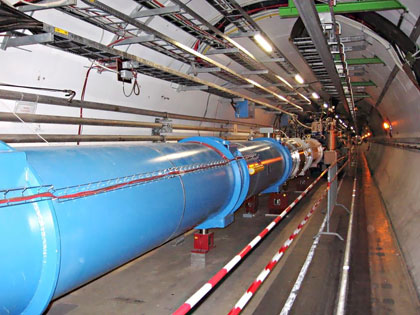
The Higgs
Image: Tunnel of the Large Hadron Collider (LHC) of the European Organization for Nuclear Research, known as CERN, with all the Magnets and Instruments. The part of the tunnel shown is located under the LHC P8, near the LHCb.
The Higgs boson is the elementary particle associated with one of four components of the Higgs field, with zero charge, spin, and colour charge. It is extremely massive and hence very unstable. The Higgs field is of fundamental importance to the standard model, for it is responsible for the breaking of the weak isospin and other symmetries. For example, in the electroweak sector, the symmetry breaking results in three components of the Higgs field being ‘absorbed’ by the SU(2) and U(1) gauge bosons (the ‘Higgs mechanism’) to become the W and Z bosons of the electroweak force. Crucially, these bosons acquire mass. Both electroweak and QCD theories are in the first instance theories of zero-mass particles: symmetry breaking by the Higgs field is the origin of all mass in the universe.
The standard model, incorporating the Higgs field and the Higgs mechanism, therefore predicts the existence of a neutral scalar field. Excitations of this field should appear as neutral, scalar particles. Such particles have been sought for more than 40 years. On 4 July 2012 it was announced at CERN that a hitherto unknown neutral particle of about the right mass had been found in LHC experiments. Subsequent investigations of its properties tentatively reveal that it has zero spin and positive parity, as required of the Higgs. Peter Higgs, together with Francois Englert, was awarded the Nobel Prize for Physics in 2013.
The structure of the Higgs field and the associated mechanism for generating mass by symmetry breaking was worked out by three groups of theorists at about the same time: by François Englert and Robert Brout, in August 1964; by Peter Higgs, in October 1964; and by Gerald Guralnik, Carl Hagen, and Tom Kibble, in November 1964.
Links
Peter Higgs: 'My life as a boson' >
Collected articles at the Guardian >
Scholarpedia: the Higgs mechanism >
Scholarpedia: Tom Kibble, ‘History of the Englert-Brout-Higgs-Guralnik-Hagen-Kibble mechanism’ >
Multimedia
Confirmed: CERN discovers new particle likely to be the Higgs boson >
Sean Carroll at the Royal Institution: The Higgs >
Announcement: the Nobel Prize for Physics 2013

